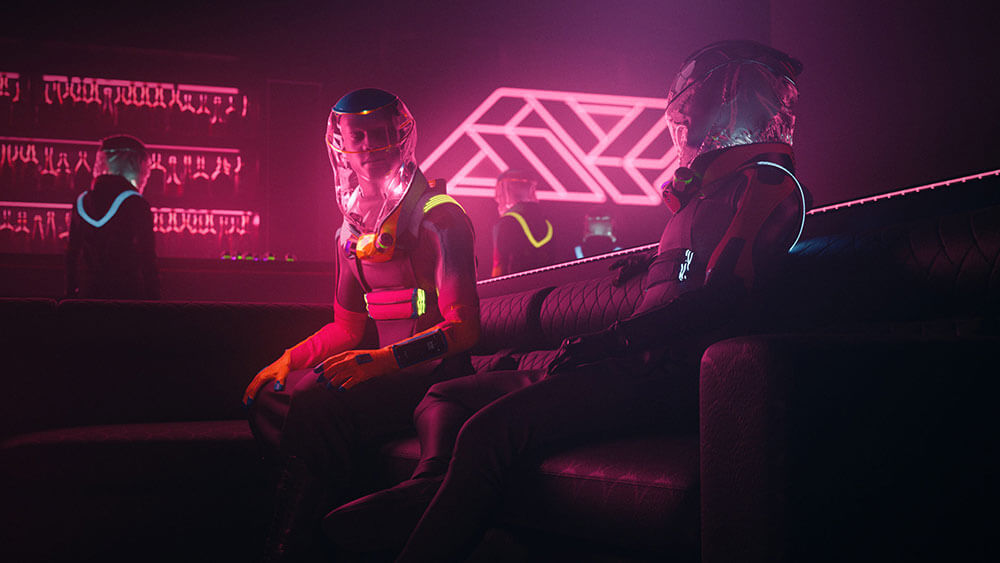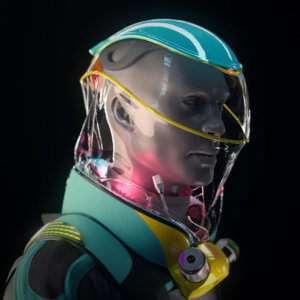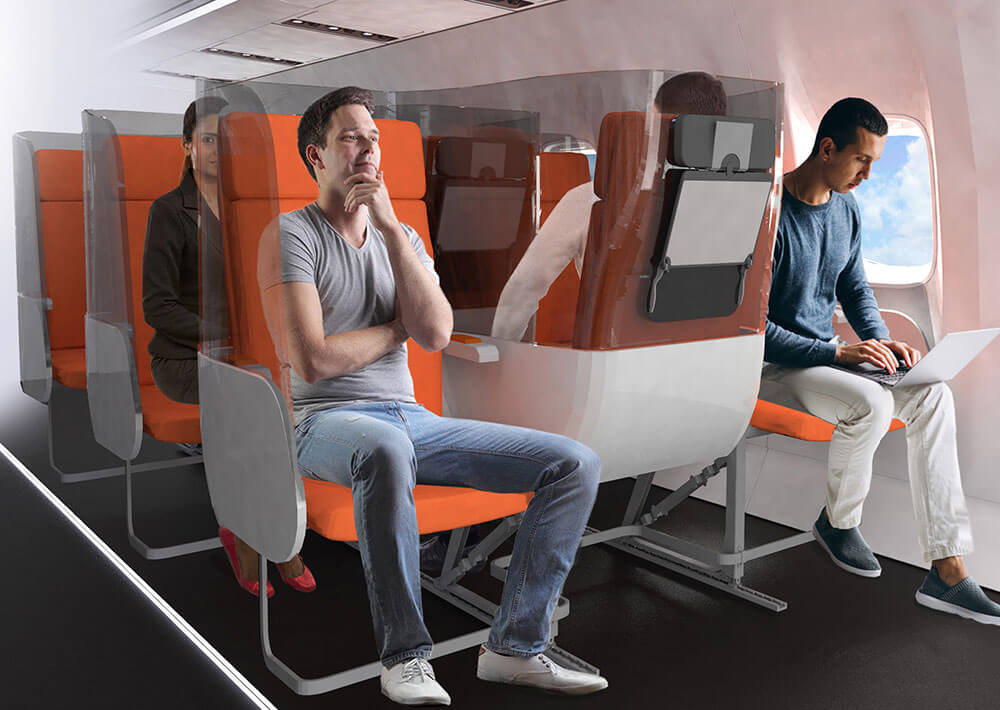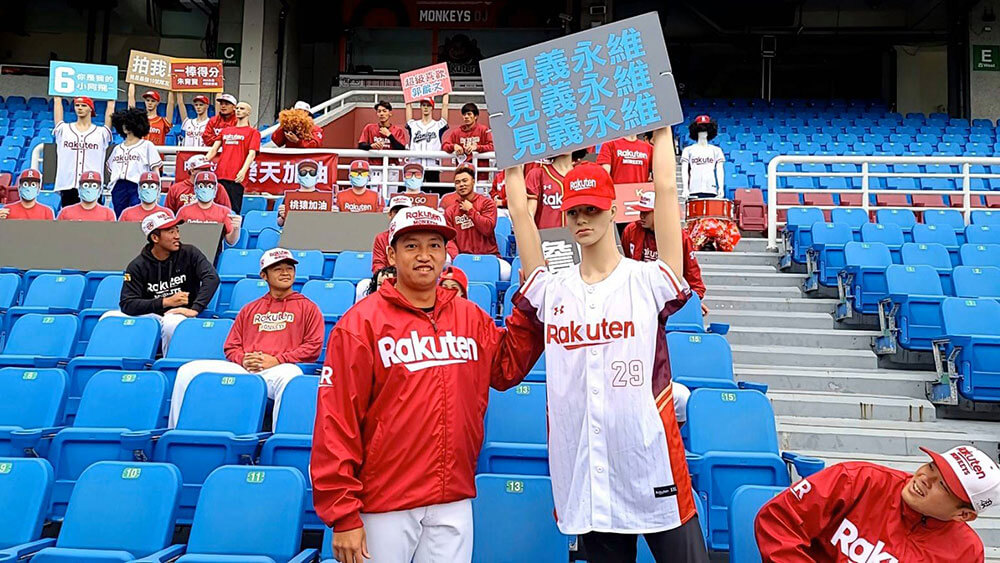
Production Club calls its hazmat suit-like Micrashell a “virus-shielded, … fun to wear” piece of personal protective equipment. (Courtesy Production Club)
The future cannot be seen through a Zoom window — no matter how many of them you open today. Sure, digital platforms have played a role in keeping us connected and working during the COVID-19 crisis, but humans crave real, in-person interaction. And the economy really, really needs it. With no approved treatment and an inevitable waiting game for a vaccine, some companies are thinking about how to shape a new normal that helps people come together while minimizing their risk of contracting the coronavirus.

Production Club’s Micrashell has an air filtration and breathing system based on worldwide standard regulations using N95 filters. (Courtesy Production Club)
Staying Social but Not Staying Apart
New airplane designs might be able to better accommodate passengers, but people still face a pressing question: How do they physically distance themselves when standing next to each other at a conference or sing along in the middle of a crowd at a show? Production Club, a Los Angeles–based company that has worked on activations at E3, Amazon’s re:MARS Party, and the Electric Jungle Music Festival, wants to outfit event-goers in its Micrashell, a hazmat-like getup that falls somewhere between astronaut suit and winner in the Most Elaborate category at your neighbor’s Halloween costume party. The company calls it “a virus-shielded, easy to control, fun to wear, disinfectable, fast to deploy personal protective equipment that allows socializing without distancing.”
I know what I’m asking for this holiday season.
RELATED: PCMA’s Catalyst Community Offers Ideas for Social Distancing at a Network Event
Pick Your Top 10 Friends
If a leaked proposal from the Belgian government gains traction, people are going to have some tough decisions to make about who they let in their tribes. The idea is built around the concept of a social bubble, a small group of 10 people who are agree to hang out with each other — and no one else. The concept, reported CNN, would translate to a dramatically different definition of being social. On the plus side, it could make it easier to say no to that dinner party you’ve been dreading.

A shield surrounding the rear-facing middle seats of Aviointeriors’ Janus Seat design is said to prevent germ spread between passengers. (Courtesy Aviointeriors)
Maximum Capacity and ‘Maximum Isolation’
Growing up, my favorite spot in the family station wagon was the rear-facing backseat. Soon enough, air passengers may get to enjoy the alternative vantage point, too, thanks to the Janus Seat design from Aviointeriors. As the airline industry looks ahead, recovery could involve looking behind with rear-facing middle seats that “ensure the maximum isolation between passengers seated next to each other.”
A barrier between each seat also creates a pod-like structure that might help avoid germs from sneezing or coughing. It may look strange to frequent travelers, but there is an additional benefit: That napping (and snoring) seat mate can no longer slump over and invade your space.
Seat Removal
As enthusiastic fans wait for a return to sporting events, some of them may be able to put a piece of the action in their living rooms. Don Barnum, head of sports at architecture firm DLR Group, told CNBC that arenas and stadiums will need to figure out how to accommodate social distancing requirements. “You just modify them,” Barnum said. “Take out the seats.”

A fan of the Rakuten Monkeys from the Chinese Professional Baseball League gets a photo with a robot “fan” at a game. The team added robots and life-sized cutouts to the stands for games. (Rakuten Monkeys Facebook)
Robot Stand-ins
A game with fans spaced six feet apart may seem strange — doing “the wave” may feel a bit barren even if your whole bubble is in attendance — but it’s certainly less awkward than plans for the Rakuten Monkeys of the Chinese Professional Baseball League. The Monkeys’ solution: robot mannequins dressed up as fans in the stands.
Elsewhere in Asia, robots — dressed in caps and gowns — were pressed into service at a university in Japan to fill in for students who were being recognized at a graduation ceremony. The robots were remotely controlled by graduating students from their homes whose faces were projected on tablets beneath the caps.
At Convene, we’re keeping our fingers crossed that the next normal of face-to-face gatherings will not include sci-fi suits and robots accepting awards. Check out our conversation with experience economy expert James Gilmore about some potential shifts for meetings and events.
David McMillin is an associate editor at Convene.
